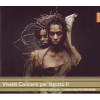Texte paru dans: / Appeared in: |
|
|
Reviewer: Bertil
van Boer Shortly abridged version:
This second
installment of works for bassoon displays some unique features that
demonstrate Vivaldi was no stranger to the stylistic trends of the time and
that he was fully capable of adapting to the more emotional Empfindsamkeit,
though not quite in as wholehearted a manner as Telemann.
There are
seven concertos on this disc, all of which demand the utmost technical
capabilities of the soloist, with wide-ranging leaps, the usual sequential
roulades spun out in rapid succession, plenty of rushing up and down scales
or arpeggios, and long sustained lyrical passages that would tax the stamina
and breath of any performer. He certainly knew the possibilities of his
instrument (and here I am tempted to propose the subtitle “Not just a
continuo instrument anymore!” but will let it pass). These he exploits not
as mere display but rather in numerous intriguing ways. In the E♭-Major
concerto, for example, the first movement has a line that soars above
tremolo strings, which along with a triadic opening belongs to the North
German world of Franz Benda or C. P. E. Bach, while the second movement is a
solemn lament with harsh unison string interjections. To be sure, the music
itself was reused from Vivaldi’s 1732 opera Semiramide, but it is effective
as a harbinger of the classical style. This same mood pervades the F-Major
concerto, where contrasting lyrical phrases abound and the strings form a
nice complement throughout, as opposed to Vivaldi’s normal pattern of
reducing accompaniment during the solo passages. The second movement’s
opening mezza di voce above string suspensions initially made me think it
was composed for horn, so clear and mellow was the line. The triplets in the
minuet third movement are again right out of the Berlin School, with little
trace of Baroque practice. This was composed in 1737, when the new style was
beginning to catch on and, what is more, it was meant for Count Morzin in
Bohemia, meaning that the composer was right in the thick of things. One
notices immediately the intensity behind some of the works, such as the
A-Minor concerto that begins the disc, with its virile martial theme that
seems almost Spanish. Not much happens harmonically here, but the imitation
of a hurdy-gurdy makes for a pleasant image, in turn achieving a lovely
contrast with the ethereal sound of the second movement with a gossamer
cloud of string suspensions through which the bassoon proceeds at a steady
pace of dotted rhythms. When halfway through a second bassoon enters with a
lovely lyrical line, the effect is stunning. In the G-Minor concerto, the
steady ostinato of the solo brings to my mind the opening of Alfred
Hitchcock’s television series, with its Gounod signature tune; the theme
weaves and bobs in continuous motion, a musical jest at its best. Alas, the
third movement of this work, despite some interesting imitation, seems more
conventional, at least for Vivaldi. In short, these are all extremely fine works, and given that all appear to have been written toward the end of his life when he had largely abandoned the Ospedale della Pietà and its precocious all-girl band, he was able to lavish considerable attention on compositional detail. About the performances, one can give them the highest accolades. The somewhat larger basic string orchestra, with its reinforced continuo, lends it a robust depth, and Diego Cantalupi keeps things moving right along. Sergio Azzolini’s solo work is astounding. His passages are clean and clear, with no burbles or scratchiness that I can detect. Indeed, his virtuosity borders on the astounding, insofar as technical display is concerned. I am now looking forward to the next installment of this series with great anticipation. This recording is definitive, as far as I am concerned, and I think those who are devoted to Vivaldi will want it and no other.
| |
|
|
|
|
|
|
|
Cliquez l'un ou l'autre
bouton pour découvrir bien d'autres critiques de CD |
|




